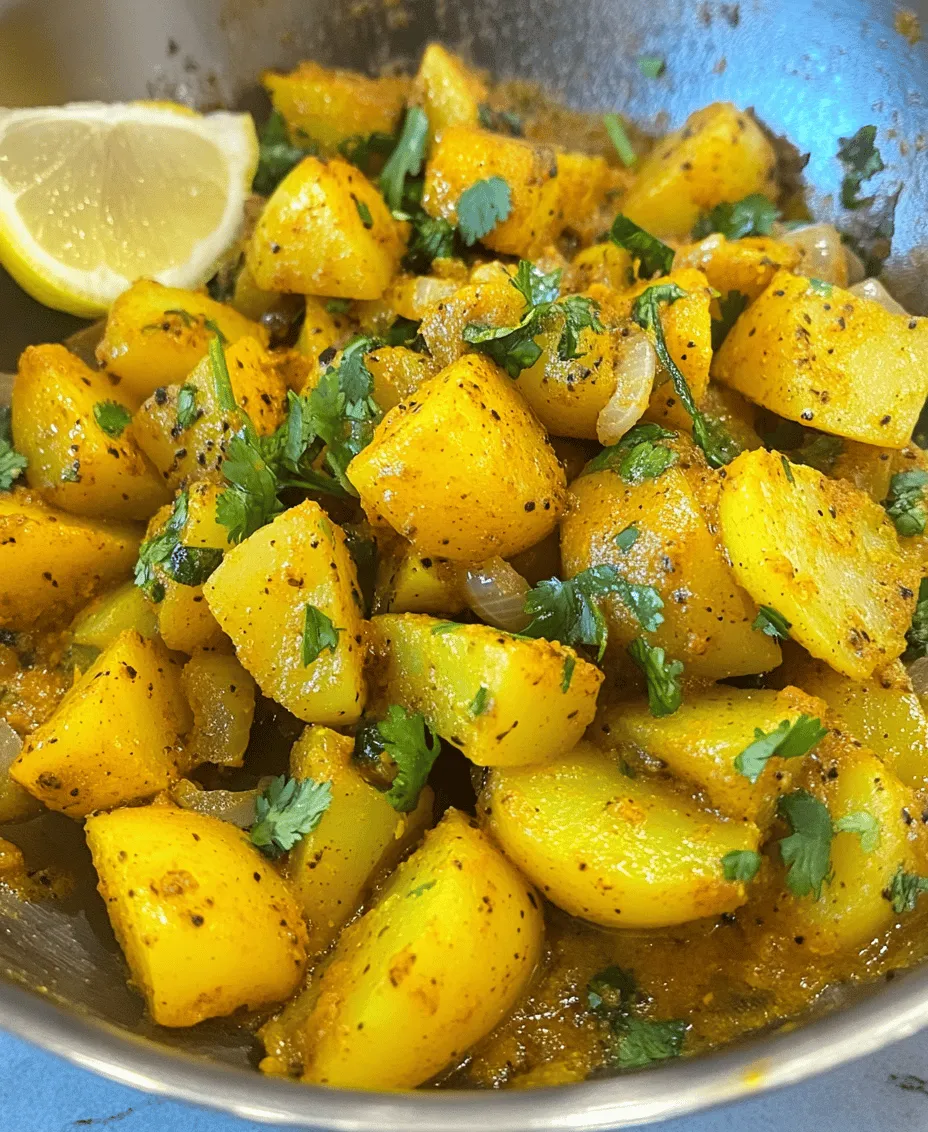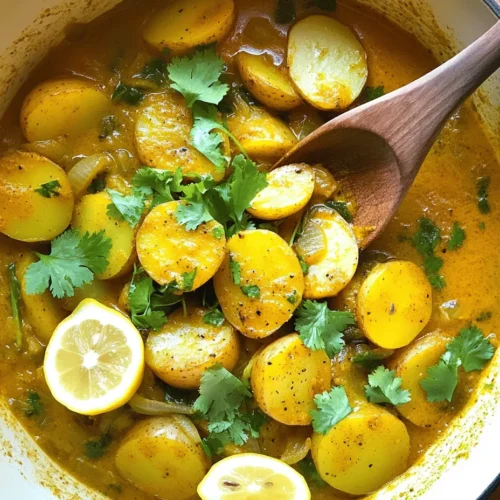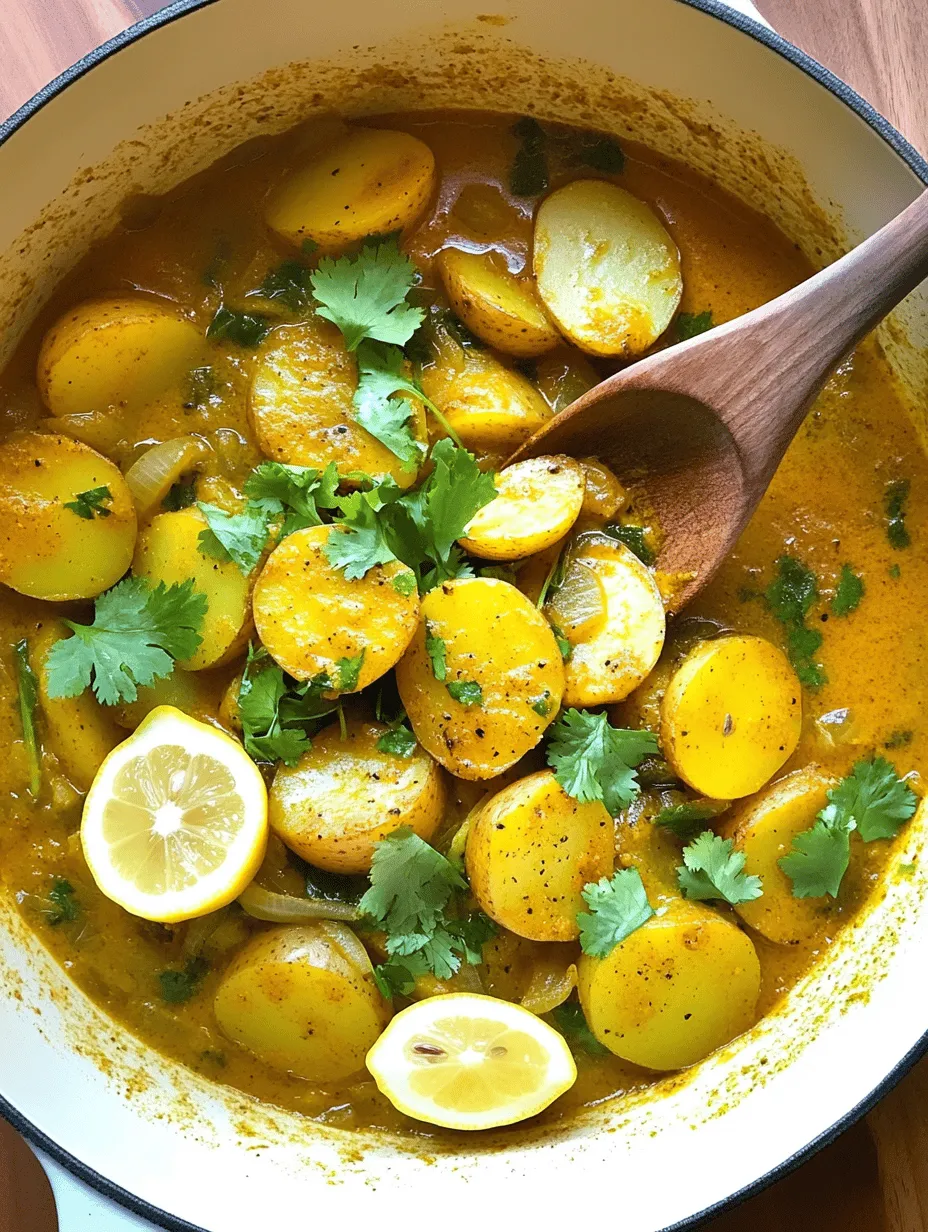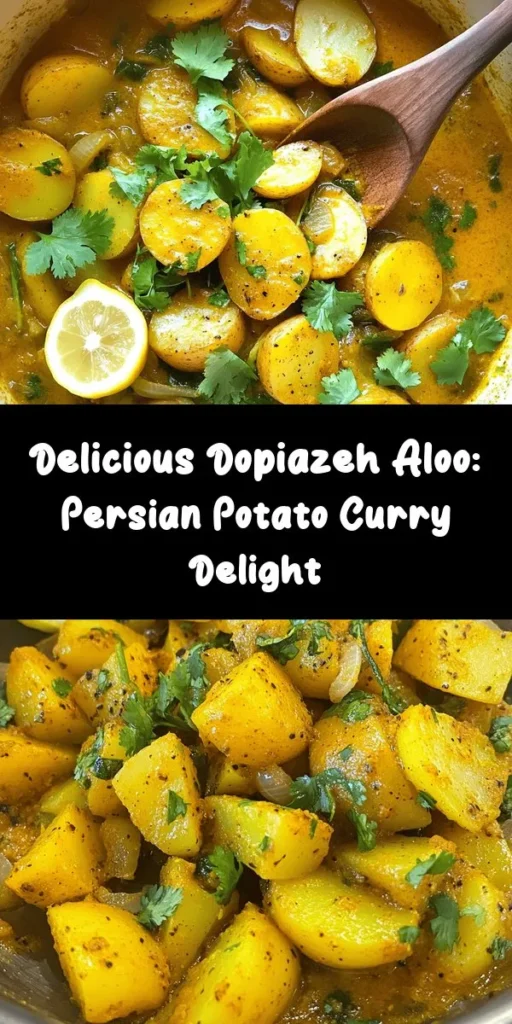Introduction
Dopiazeh Aloo is a beloved dish in Persian cuisine that embodies the essence of comfort food with its warm, hearty flavors. This Persian potato curry is more than just a satisfying meal; it is a celebration of the rich culinary heritage of Iran. Persian cooking is renowned for its use of fresh ingredients, aromatic spices, and vibrant flavors, all of which come together in Dopiazeh Aloo. This dish features tender potatoes simmered in a fragrant sauce, making it a staple in many Iranian households.
Comfort food holds a special place in Persian culture, often evoking memories of family gatherings and shared meals. Dopiazeh Aloo, with its deeply comforting flavors and rich history, resonates with many who seek to enjoy the warmth and familiarity of home-cooked meals. The combination of spices and herbs in this recipe creates a unique flavor profile that is both enticing and satisfying, making it an excellent choice for any occasion.
In this article, we will explore the delightful world of Dopiazeh Aloo, detailing its background, ingredients, and the initial steps to create this delicious curry. Whether you are a seasoned cook or a beginner looking to explore Persian cuisine, this recipe will guide you through the process of crafting this flavorful dish.
Understanding Dopiazeh Aloo
The name “Dopiazeh Aloo” derives from Persian roots, where “Dopiazeh” translates to “two onions,” and “Aloo” means “potato.” This name reflects one of the dish’s defining characteristics: the generous use of onions, which are integral to its flavor and texture. In Persian culinary tradition, onions are often used as a base for many dishes, providing depth and sweetness when caramelized.
Dopiazeh Aloo has historical significance in Persian cuisine, representing the adaptability of traditional recipes. Potatoes were introduced to Iran in the 17th century and quickly became a beloved ingredient, especially in stews and curries. The integration of potatoes into Persian cooking demonstrates the culture’s ability to embrace new ingredients while creating dishes that are deeply rooted in their culinary identity.
The flavor profile of Dopiazeh Aloo is a harmonious blend of savory, sweet, and aromatic notes. The dish typically features warm spices such as turmeric, cumin, and coriander, which are essential components of Persian cooking. Fresh herbs, particularly cilantro and parsley, add brightness and freshness to the dish, enhancing its overall appeal. The combination of these ingredients results in a comforting yet complex flavor that is sure to delight anyone who tries it.
Ingredients Breakdown
To prepare Dopiazeh Aloo, you will need a selection of fresh ingredients that work together to create a rich and satisfying curry. Here’s a detailed breakdown of each ingredient and its role in this traditional dish:
– Potatoes: The star of the dish, potatoes provide a creamy texture and absorb the flavors of the spices beautifully. For the best results, choose starchy varieties like Russet or Yukon Gold, as they hold their shape well during cooking while also becoming tender.
– Onions: As the name suggests, onions are crucial to Dopiazeh Aloo. They are typically sliced and sautéed until golden brown, which enhances their natural sweetness and forms the aromatic base of the curry. Using both yellow and red onions can add depth to the flavor.
– Garlic: Fresh garlic adds a pungent, savory note that complements the sweetness of the onions. It is usually minced and sautéed briefly with the onions to release its aroma.
– Tomatoes: Fresh or canned tomatoes contribute acidity and moisture to the dish. They balance the richness of the potatoes and provide a vibrant color to the curry.
– Spices: A blend of spices is essential for creating the signature flavor of Dopiazeh Aloo. Common spices include turmeric, which adds warmth and a beautiful golden hue; cumin, which brings an earthy depth; and coriander, known for its bright, citrusy undertones.
– Herbs: Fresh herbs like cilantro and parsley are often added near the end of cooking to enhance the dish’s freshness. They not only elevate the flavor but also contribute to the vibrant presentation.
– Salt and Pepper: Essential seasoning ingredients, salt, and pepper are used to enhance the overall flavor of the dish. Adjusting these to taste is important for achieving the perfect balance.
– Oil: Cooking oil, such as vegetable or olive oil, is necessary for sautéing the onions and garlic. The oil also helps in the even cooking of the potatoes and spices.
The choice of ingredients can vary based on regional differences and personal preferences. For instance, some people might add green bell peppers for added crunch or adjust the spices based on their heat tolerance. The beauty of Dopiazeh Aloo lies in its versatility, allowing cooks to make it their own while still honoring traditional Persian flavors.
Step-by-Step Cooking Instructions
Preparing the Potatoes
The first step in creating Dopiazeh Aloo is preparing the potatoes. Start by selecting the right type of potatoes for this dish. Starchy potatoes are preferred because they create a tender, creamy texture when cooked. Once you have your potatoes, wash them thoroughly to remove any dirt.
Next, peel the potatoes and cut them into medium-sized cubes. To prevent browning and maintain their color, soak the cubed potatoes in a bowl of water while you prepare the other ingredients. This step helps to remove excess starch and keeps the potatoes from oxidizing, ensuring they retain their appealing appearance in the final dish.
Cooking the Onions
Once the potatoes are prepped, it’s time to focus on the onions, which form the aromatic foundation of Dopiazeh Aloo. Heat a generous amount of oil in a large pot or skillet over medium heat. Add the sliced onions and sauté them, stirring occasionally to ensure even cooking.
The goal is to achieve a perfect golden brown color. This process can take around 10-15 minutes, so be patient; the caramelization of onions is key to developing the dish’s rich flavor. Once they have turned a deep golden hue, add the minced garlic and sauté for an additional minute until fragrant. Be careful not to burn the garlic, as it can turn bitter.
Toasting the Spices
With the onions and garlic cooked to perfection, it’s time to toast the spices. Remove the pot from the heat briefly and add the turmeric, cumin, and coriander. Carefully stir the spices into the onion mixture, allowing them to toast for about 30 seconds. This step is crucial as it helps to release the essential oils in the spices, enhancing their flavor and aroma.
Once the spices are fragrant, return the pot to the heat and add the chopped tomatoes. Stir everything together, allowing the mixture to cook for a few minutes until the tomatoes break down and blend with the onion and spices, forming a rich sauce.
Combining Ingredients
Now it’s time to bring the dish together. Drain the soaked potatoes and add them to the pot, gently mixing them with the onion and spice mixture. This layering of flavors is essential in building the taste profile of Dopiazeh Aloo. Next, pour in enough water or broth to cover the potatoes, ensuring they cook evenly and absorb all the aromatic flavors.
Bring the mixture to a gentle boil, then reduce the heat to low and cover the pot. Allow the potatoes to simmer for about 20-25 minutes, or until they are tender and have absorbed the flavorful sauce. During this time, check occasionally to ensure the potatoes are not sticking to the bottom of the pot, adding more liquid if necessary.
As the Dopiazeh Aloo simmers, the kitchen will fill with the enticing aromas of spices and cooked potatoes, promising a delicious meal ahead.
Stay tuned for the next part of the article, where we will cover additional tips for achieving the best results, including serving suggestions and common questions related to this delightful Persian curry.

Incorporating Tamarind
Tamarind is a key ingredient that adds a distinctive tanginess to Dopiazeh Aloo, elevating the dish from simple comfort food to a complex flavor experience. Derived from the tamarind tree, this pod-like fruit is commonly used in various cuisines around the world, particularly in South Asian and Middle Eastern dishes. In the context of Dopiazeh Aloo, tamarind provides a subtle sourness that balances the sweetness of the caramelized onions and the earthiness of the potatoes.
To incorporate tamarind into your curry, you can use tamarind paste or soak tamarind pulp in warm water to extract its juice. Typically, just a tablespoon or two is sufficient to achieve the desired tartness without overwhelming the other flavors in the dish. The key is to add the tamarind towards the end of the cooking process, allowing it to meld with the other ingredients while ensuring that its tangy notes remain pronounced.
Simmering the Curry
Simmering is one of the most critical steps in preparing Dopiazeh Aloo, as it allows the flavors to blend harmoniously and the potatoes to become tender. After bringing your curry to a boil, reduce the heat to low and let it simmer gently. This slow cooking process is essential for a few reasons. First, it allows the potatoes to absorb the rich spices and flavors, making each bite more satisfying. Second, simmering helps to break down any tough fibers in the potatoes, resulting in a creamy texture that is both delightful and comforting.
The ideal simmering time for Dopiazeh Aloo is about 20 to 30 minutes, but keep an eye on the potatoes to ensure they remain intact. If you prefer a thicker curry, you can simmer it uncovered for the last 10 minutes, allowing some of the liquid to evaporate and intensifying the flavors. Just remember to stir occasionally to prevent sticking and burning.
Final Touches
As you approach the end of your cooking process, it’s time to add the final touches that will elevate your Dopiazeh Aloo. Start by tasting the curry and adjusting the seasoning. Depending on your palate, you may want to add more salt, a pinch of sugar to balance the acidity from the tamarind, or additional spices like cumin or coriander.
For the perfect texture, consider adding a splash of water if the curry appears too thick, or allowing it to simmer for a few more minutes if it seems too runny. The goal is to achieve a creamy, cohesive consistency that coats the potatoes beautifully while still being pourable over rice or bread.
Once the seasoning is adjusted, finish the dish with a sprinkle of fresh herbs like cilantro or mint for a vibrant pop of color and freshness. Not only do these herbs enhance the visual appeal of the dish, but they also add an aromatic quality that complements the rich flavors of the curry.
Serving Suggestions
Dopiazeh Aloo is traditionally served with basmati rice or flatbreads, allowing you to scoop up the rich curry with each bite. For a classic presentation, serve the curry over a mound of fluffy basmati rice, garnished with a sprig of fresh cilantro. The aromatic rice pairs perfectly with the spiced potatoes, creating a satisfying meal that is both filling and flavorful.
For a modern twist, consider pairing Dopiazeh Aloo with artisan flatbreads, such as naan or pita. These breads not only provide a delightful texture but also offer a fun and interactive way to enjoy the dish. Guests can tear off pieces of bread and use them to scoop up the curry, making for a communal dining experience that encourages conversation and connection.
When it comes to visual presentation, consider serving Dopiazeh Aloo in a vibrant, colorful bowl. A bright blue or yellow dish can enhance the warm hues of the curry and create an inviting ambiance at the dining table. Adding a few slices of lemon or lime next to the curry can also add a pop of color and provide a fresh contrast to the rich flavors of the dish.
Nutritional Information
Dopiazeh Aloo is not just a delicious dish; it also offers a variety of nutritional benefits. Potatoes are the star ingredient, providing a good source of carbohydrates, vitamins, and minerals, particularly vitamin C and B6. They are naturally low in fat and high in fiber, making them a filling option that can help with digestion.
The spices used in Dopiazeh Aloo, such as turmeric and cumin, not only contribute to the flavor but also possess numerous health benefits. Turmeric contains curcumin, known for its anti-inflammatory properties, while cumin is known to aid digestion and boost the immune system.
To make Dopiazeh Aloo healthier without compromising flavor, consider the following modifications. You can reduce the amount of oil used in the initial frying of the onions and potatoes or substitute with a healthier oil like olive oil. Additionally, you can increase the proportion of vegetables by adding peas, carrots, or bell peppers, which will enhance both the nutritional profile and color of the dish.
Cultural Significance of Dopiazeh Aloo
In Persian culture, food plays a significant role in family gatherings and celebrations, and Dopiazeh Aloo is no exception. This hearty potato curry is often served during festive occasions, symbolizing warmth, comfort, and togetherness. It is not uncommon for families to gather around the table, sharing stories and enjoying the flavors of this beloved dish.
Dopiazeh Aloo is often compared to other Persian dishes that feature a similar combination of spices and ingredients, such as Khoresh Gheymeh (a split pea and meat stew) or Fesenjan (a pomegranate and walnut stew). Each dish tells a story of Persian culinary tradition, showcasing the region’s love for bold flavors and aromatic spices.
Personally, I recall countless family dinners centered around a steaming pot of Dopiazeh Aloo. The laughter, the stories shared, and the delicious aroma wafting through the house created memories that linger long after the meal was finished. This dish holds a special place in my heart, reminding me of the importance of family and the joy of sharing a meal together.
Conclusion
Dopiazeh Aloo is not just a dish; it is a culinary experience that encapsulates the essence of Persian cuisine. With its unique blend of flavors, the tanginess from tamarind, and the comforting texture of potatoes, this curry has the power to bring people together and create memorable dining experiences.
Whether enjoyed during a festive celebration or a simple weeknight dinner, Dopiazeh Aloo continues to be a beloved staple in many households. Its enduring popularity is a testament to the rich culinary traditions of Persia and the universal appeal of delicious food. By preparing and sharing this dish, you not only indulge in a flavorful meal but also partake in a cultural legacy that celebrates community, family, and the joys of cooking. So, gather your loved ones, serve up a generous portion of Dopiazeh Aloo, and savor the connections that this delightful dish fosters.



